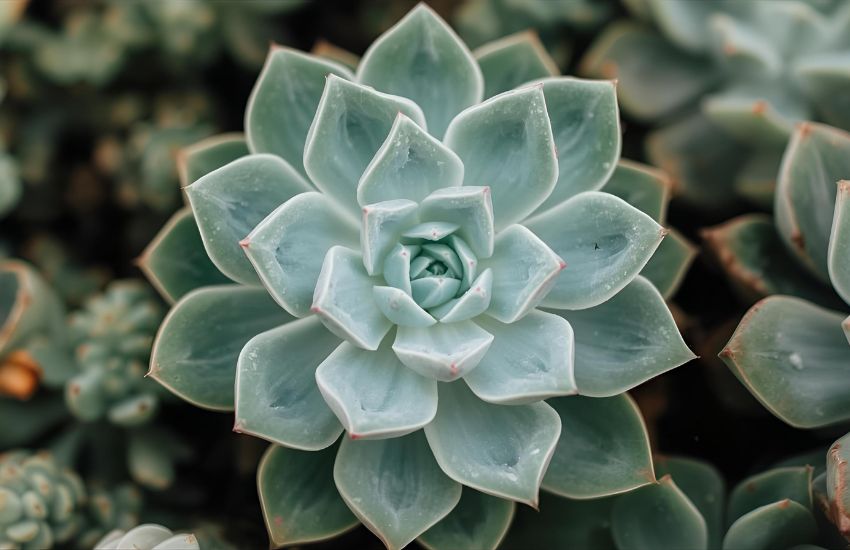The search for a plant that blends beauty, resilience, and fuss-free nature often leads you to the echeveria pegasus plant, a captivating succulent admired by both beginners and seasoned collectors. Known for its compact growth habit and symmetrical rosette shape, this beautiful rosette succulent with elegantly curved ends and a pointy tip is perfect for adding charm to your garden or enhancing your indoor spaces. Its fleshy leaves have a bluish-green tone and grow in diameter to overtake the entire top of the planter, creating a striking centerpiece wherever you place it.
The Echeveria Pegasus plant is a stunning succulent that enhances both gardens and indoor spaces with its rosette-shaped, pastel-toned leaves. Low-maintenance and drought-tolerant, it thrives with minimal care, making it ideal for modern, sustainable living. Whether placed in pots, arrangements, or outdoor landscapes, this succulent gem brings elegance, beauty, and lasting charm to your home.
In this blog, you will explore how to care for this charming succulent, from choosing the right pot and soil to learning when to repot, water, or even use a cutting for propagation. You’ll also discover practical tips on fertilizer use, sunlight needs, and how to help your echeveria pegasus plant truly thrive as a stunning, low-maintenance addition to your home or garden.
Why the Echeveria Pegasus Succulent is Perfect for Modern Plant Lovers

A Stylish and Adaptable Choice
The Echeveria Pegasus is a charming succulent that easily fits into both minimalist homes and lush green corners. Known for its compact form and fuss-free nature, it appeals to modern plant lovers who value beauty without complexity. You can place it in a small cylindrical pot and watch the rosette grow in diameter, creating a striking visual statement that feels elegant yet effortless. Its symmetrical rosette growth makes it a well-suited choice for those who want a plant that looks polished with minimal effort.
Low-Maintenance Beauty for Beginners
If you are a beginner, this succulent plant housed in the right potting mix will give you a confident start. It is low maintenance and thrives in bright conditions, but it adapts just as well indoors with indirect sunlight. To keep it healthy, water it once in two weeks or sparingly to avoid rot. This is one plant that does not really need feeding often, but if it ever needs a pick-me-up, you can opt for a liquid fertilizer to give it a gentle boost.
Perfect for Different Locations
The best location for the echeveria plant depends on how much access to sunlight your home or garden offers. Outdoors, it thrives in rock gardens where direct light enhances its color. Indoors, indirect sunlight helps preserve its fresh bluish-green leaves. Whether you use the echevarria to add a sculptural accent to your desk or showcase it in a red pot comes with your décor theme, this succulent is versatile enough to complement any style.
A Plant That Grows with You
Over time, you will notice the pot and watch the rosette expand as the leaves become big compared to the old ones. As you watch the rosette grow, the plant continues to display its enduring appeal. This growth habit, combined with its ability to adapt to different conditions, makes it a well-suited and stylish companion for today’s busy lifestyle.
Conclusion
The Echeveria Pegasus stands out among echeverias as a truly charming succulent that requires minimal effort while offering maximum beauty. Its fleshy leaves arranged in a symmetrical rosette make it a natural showpiece whether you keep it indoors or outdoors.
Ideally, the echeveria plant is a sunny choice for modern homes, thriving best when the plant is a sunny spot where he can bask in the morning and some afternoon light. To avoid rot, water to keep the top soil just slightly moist, never soggy, as this helps protect its roots. For healthy growth, a 130mm diameter container is often ideal, allowing the rosette to spread gracefully as it matures.
With its low-maintenance nature, timeless design, and adaptability, the Echeveria Pegasus is a must-have for any collection. If you’re ready to elevate your green space with a succulent that thrives effortlessly, add this exquisite plant to your garden or home décor today.
Frequently Asked Questions (Echeveria Pegasus Plant: A Succulent Gem for Garden and Home)
Is echeveria a lucky plant?
Yes, Echeveria is often considered a lucky plant. Its rosette shape symbolizes prosperity, growth, and positive energy. Many people keep it indoors or at work to attract good fortune and harmony. Additionally, its easy care and beauty make it a symbol of resilience and natural balance.
Is echeveria indoor or outdoor?
Echeveria can thrive both indoors and outdoors, depending on the environment. Indoors, it prefers bright, indirect sunlight and well-draining soil. Outdoors, it grows well in sunny, dry conditions. Protect it from frost and excessive rain, as Echeveria is sensitive to cold and overwatering.
Does echeveria need sun or shade?
Echeveria plants need plenty of bright sunlight to thrive. They prefer full sun to partial shade, ideally receiving at least four to six hours of direct light daily. Insufficient sunlight can cause leggy growth and dull leaves, while too much harsh sun may scorch their delicate foliage.
How fast does echeveria grow?
Echeveria grows relatively slowly, typically producing new leaves and small rosettes over several months. Under ideal conditions with plenty of bright sunlight, well-draining soil, and minimal watering, it can reach maturity in two to three years. Growth rates vary depending on the species and care provided.
